History of Social Media
Often dubbed one of the greatest innovations of humanity, the story of social media has a long and complex history.

Social media has often been described as the “greatest innovation” of the past few decades, only growing in prominence around the world. On Facebook alone, our “super social” planets most popular platform, over 1.7 billion users actively logged in. That’s more than 1/7th of the entire population – a number not replicated that often in the world of technology.
What many people don’t know is that social media has been developing since as early as the 1970s, back when newsgroups, chat rooms and message boards were our equivalent of Twitter timelines of Facebook friends. One thing is widely known, however, and that’s the acknowledgement of a “golden era” for social media – the year 2001 boasting this title.
First came Wikipedia, the first crowdsourced encyclopedia online, and then followed the long-long ‘Friendster’, the controversially hated ‘MySpace’, then the media-Gods Facebook and Twitter.

Social media monitoring platform ‘Simplify360’ created a brilliant simple infographic to map the evolution of social media. Here are some of the main changes, with my own commentary and famous quotes about them.
The Primitive Era of Social Media
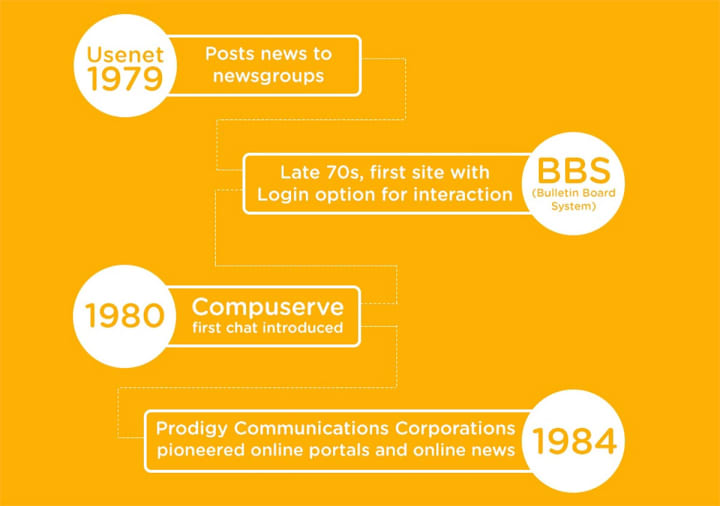
1980 – Compuserve was released, which allowed for the first chat abilities; this introduction to the social media world was, while grassroots, revolutionary in that it allowed two or more individuals to chat fluently online without the use of emails.
The Medieval Era of Social Media
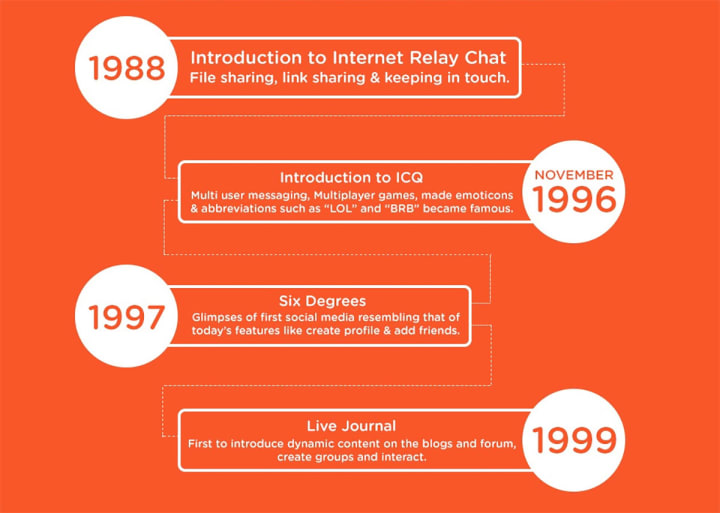
1988 – The ‘Internet Relay Chat’ was released, allowing for the sharing of files, links and general ‘keeping in touch’. IRCs are still in use today, often favoured by users wishing to remain anonymous, but their early uses were mind-blowing in nature. Being able to share files with a large audience was lightyears ahead of the monotonous and slow process of emailing, or sending awkward floppy disks through the post.
1996 – Welcome to ‘ICQ’, which allowed for multiple people to share the same chat, introduced multiplayer games, made emoticons and created the beloved abbreviations “lol” and “brb”. To me, ICQ acts as one of the power players to modern social media, yet doesn’t hold much recognition. It’s arguably because of ICQ that emoji’s are so popular today, or why countless abbreviations are commonplace online.
Golden Era of Instant Information and Virtual Friendships
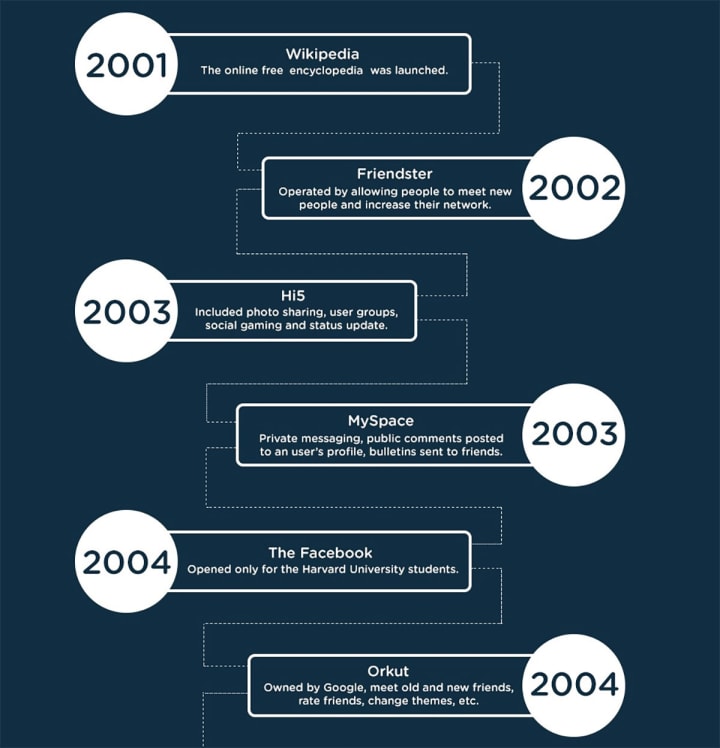
2001 – Wikipedia was released! Not much has to be said about what it is, as I’m almost certain everyone reading this has used it at least once. For those who don’t know, it is an online free encyclopedia of everything, from Star Wars to micro-expressions and everything in between and beyond. Now 15 years old, Wikipedia continues to inform the internet in unparalleled and unmatched ways, and now is commonly cited in doctorate degrees.
2003 – MySpace reveals its unique face to the masses online as the newest and most revolutionary in social media. Allowing for private messaging, allowing users to write public comments on other’s walls and giving current friends updates about your life. Luckily, I entered the social media scene just after MySpace, so quickly learned of its prominence in modern technological societies from a young age, but also of how easy it was to post cringe-worthy and, at times, incriminating information about you. As a result, ‘online crimes’ began to slowly rise, ranging from stalking and abuse to identity theft and the arrangement of ‘physical crimes’ by meeting in real life.
2004 – The Facebook was founded – and yes, that wasn’t a typo. ‘The Facebook’ was originally opened only for Harvard University students created by then-student Mark Zuckerberg. It was then opened to neighboring universities, then ones nationally and then…Well, Facebook became a thing. Whilst I didn’t use The Facebook, one of my ‘bosses’ did and recently told us of his early stories on the platformer (he was a former Harvard student) and how, even for the most brilliant of academic minds, the newest in social media sites blew their minds.
Era of Image and Video Sharing
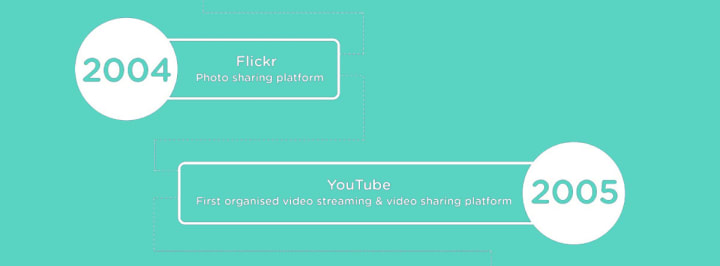
2004 – Flickr is born, revolutionizing image-based social media, with the main aim of being able to share photographs at a high quality, and allowing for user interactions based on these photos. Mainly used by professional photographers, Flickr allowed it’s users to almost create portfolios, and the social media site is often attributed with ‘creating’ many photographers careers by being recognized by big corporations. Whilst I don’t use Flickr for my own photography, I have seen examples time-after-time of people gaining major success for their posts.
2005 – The brilliant and now-controversial YouTube is released, which is described as the “first organized video streaming and video sharing social media platform”. Originally bearing only videos of staffers endeavors around the world, the platform quickly established regular and prominent users, aptly named “YouTubers” and is now the most used video-platform in the world. It has recently come under fire for some controversial and vague advertising rules, such as discouraging “foul language” and “controversial discussions”, causing large-scale confusion and distain with it’s users.
Beginnings of the Internet Troll
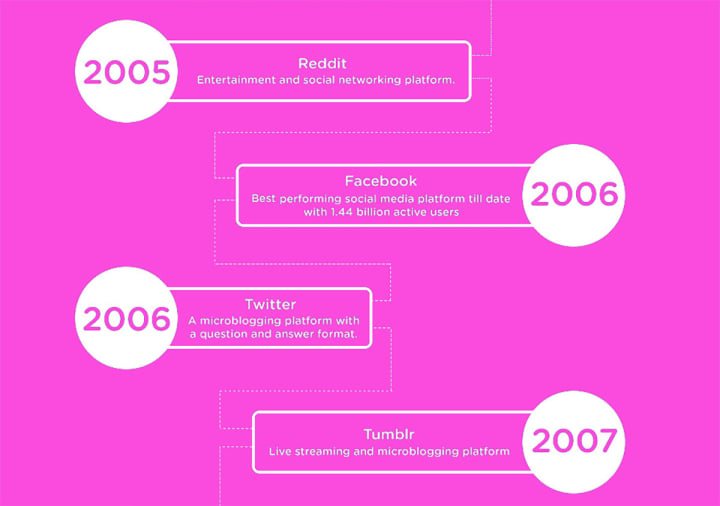
2005 – Reddit is released, allowing for users to post on public ‘boards’ about news, current events, sports, hobbies and almost everything else. It quickly became the ‘go-to’ for some news platforms, and subsequently allowed for notable figures to engage with their fans, such as astronauts, singers, politicians and many more. My personal experience with Reddit is pretty lame, namely because I got ‘ghost-blocked’ on my first day, but it’s enjoyable finding far-fetched and entertaining user-submitted stories on some of the storyboards.
2006 – Facebook is released, minus ‘The’. That’s right, it finally dropped the annoying The and focused on captivating the world, rather than solely students. And it worked. Massively. Facebook is now the best performing social media platform in history, with over 1.7billion active users and growing. Whilst it has come under fire recently for the suppression of the female body and political ideologies, it continues to innovate with new livestream features, memory-throwbacks, friend suggestions and even tailored advertising to make it a better, and hopefully more useful, experience through your scrolling. The reformed Facebook quickly took over its competitors in the market, and even shortly after its release dominated over the likes of MySpace and YouTube.
2006 – Twitter is then released as direct competition to the new Facebook, acting instead as a ‘microblogging’ social media platform with a “question and answer” format in mind. Whilst it has never beaten Facebook, it has always been deemed as both an alternative, and a sister-site to the media supergiant. Utilizing quick 140-character posts, image sharing and livestream capabilities and a focus on celebrity-fan interaction, Twitter maintains a strong position in the social media world, despite recent economic flutters.
2007 – The viral meme-making, aesthetic-sharing blogging website Tumblr is founded, allowing users world-wide to create open ‘blogs’ to post anything they want, from lengthy text posts, to images, to quick videos to gifs. Lots and lots of gifs. Tumblr is also attributed to the modern rise in ‘fandoms’ and series spin-offs, and also boasts a lot of porn blogs. So basically anything for anyone exists on Tumblr!
The New Future of Chatting and Connecting
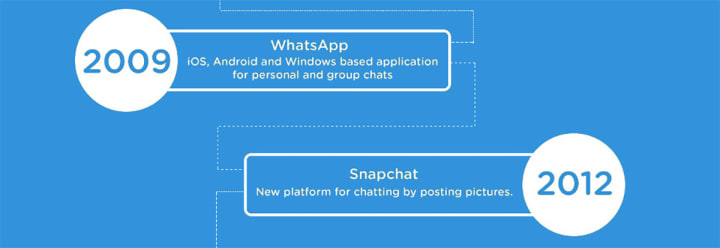
2009 to 2012 – WhatsApp and Snapchat are released respectively, opening up the world of social media with the specific target of the mobile market; smartphone users. They were greeted with instant success, with WhatsApp blazing the trail for secured private chats (and with that, many security downfalls – it’s been credited with the sharing of terrorist plans) and Snapchat reigniting adoration for the front-facing camera. Snapchat then went on to further innovate ‘selfie’ taking with the purchase and utilization of facial-morphing technologies to make some pretty awesome filters.
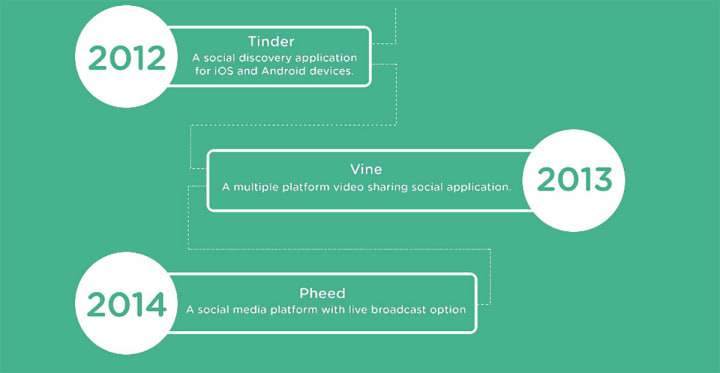
2012 to Now – Dating app Tinder and short-video platform Vine are released, also both to instant success. The revolutionary dating app named ‘Tinder’ which was marketed after the gay dating app 'Grindr', while refuting criticisms and fears of security, allowed users to network with others close-by, arrange dates and generally chat. A few crimes were attributed to the hook-up app, but in the most part remained a safe and fun way of meeting strangers in the modern ‘social-media driven’ society we live in. Quite a lot of Tinder babies now exist in the world, which is pretty cute too! Vine, on the other hand, operated as a direct opponent to YouTube, instead focusing on short 7-second-clips designed to maximize attention and engagement. That also worked, and many ‘Vine celebrities’ have been made in the process, notably a cheery, modern-humor guy called “King Bach”.
About the Creator
Benjamin Wareing
Journalist and photographer. News, opinions and politics are my forte. Futuristic dystopian is my kink.






Comments
There are no comments for this story
Be the first to respond and start the conversation.